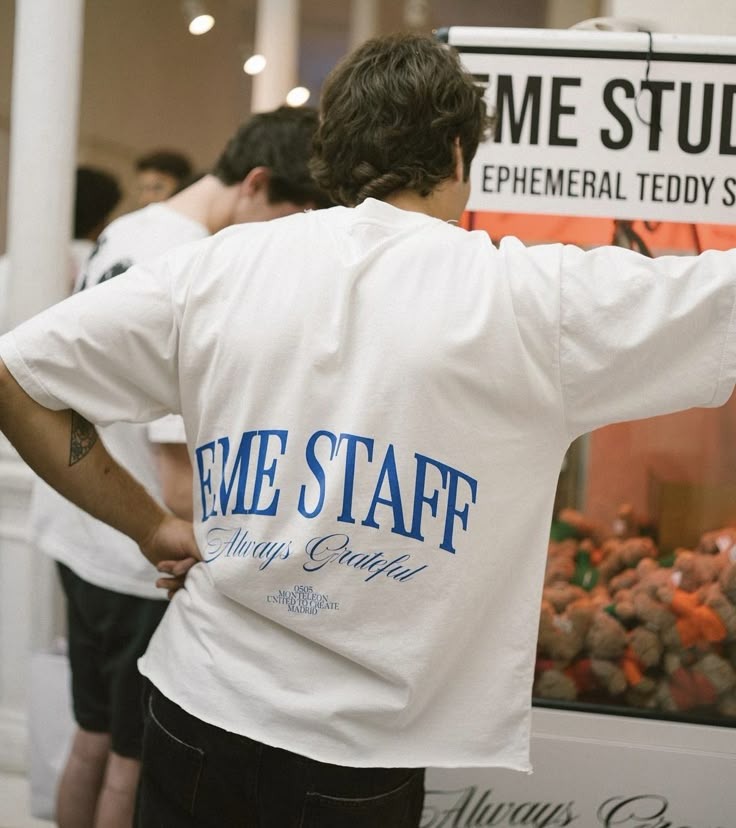The T-shirt is more than just a simple piece of clothing—it is an icon of modern style, a canvas for creative expression, and a reflection of evolving cultural trends. From its humble beginnings as an undergarment, the T-shirt has transcended its original purpose to become a ubiquitous garment that blends comfort, practicality, and style. In this article, we explore the rich history, cultural impact, design evolution, and future prospects of the T-shirt, revealing why it remains one of the most beloved articles of clothing around the world.
A Brief History of the T-Shirt
The origins of the T-shirt can be traced back to the early 20th century. Initially used as an undergarment by the U.S. Navy during World War II, the T-shirt was valued for its simplicity, comfort, and ease of mass production. Soldiers appreciated its lightweight nature and breathability, qualities that later made it a favorite in everyday wear. Post-war, the garment quickly transitioned from military attire to civilian fashion, driven by its practicality and the burgeoning desire for casual clothing.
By the 1950s, Hollywood stars like Marlon Brando and James Dean had popularized the T-shirt as a symbol of rebellion and counterculture. The simple white T-shirt, in particular, became synonymous with a nonchalant, effortless cool that appealed to a generation eager to break free from the rigid norms of previous decades. This period marked the beginning of the T-shirt’s transformation into a statement piece, one that could carry messages of individuality and defiance.
The Evolution of Design
Over the decades, the design of T-shirts has evolved significantly. Initially produced in a limited range of colors and cuts, T-shirts have diversified to include a myriad of styles, fabrics, and prints. The modern T-shirt can feature intricate designs, bold graphics, and innovative cuts that cater to various tastes and occasions. Designers now experiment with fabric blends, including organic cotton, bamboo, and recycled materials, to create garments that are not only stylish but also environmentally sustainable.
Graphic T-shirts, one of the most popular iterations, serve as wearable art. They often feature logos, slogans, or images that resonate with social, political, or pop-cultural themes. This evolution in design has turned the T-shirt into a medium for self-expression, allowing wearers to broadcast their beliefs, affiliations, and personalities without uttering a word.
Materials and Production
The production of T-shirts involves a combination of traditional techniques and modern innovations. Most T-shirts are crafted from cotton due to its softness, breathability, and durability. However, the growing emphasis on sustainability has encouraged manufacturers to explore alternative materials. Organic cotton, for instance, is grown without synthetic pesticides or fertilizers, reducing its environmental footprint. Additionally, recycled polyester is becoming popular, especially in performance wear, as it reduces waste by repurposing plastic bottles and other discarded materials.
Cutting-edge technologies in textile production have also improved the quality and efficiency of T-shirt manufacturing. Digital printing has revolutionized how designs are applied, offering high-resolution graphics with vibrant colors that remain intact after multiple washes. These technological advancements ensure that T-shirts remain affordable while meeting the high-quality standards expected by modern consumers.
T-Shirts as a Cultural Phenomenon
The cultural impact of the T-shirt cannot be overstated. As a piece of clothing that transcends age, gender, and socioeconomic status, the T-shirt serves as a cultural equalizer. It is worn by people from all walks of life, from blue-collar workers to fashion-forward celebrities. In many ways, the T-shirt is a mirror reflecting the societal values and trends of its time.
During the 1960s and 1970s, T-shirts became a powerful medium for political and social expression. Activists and protestors used them to spread messages of peace, equality, and revolution. The garment played a key role in movements such as civil rights and anti-war protests, symbolizing unity and the fight against injustice. Today, T-shirts continue to carry powerful messages, from environmental activism to social justice causes, proving that they are much more than a simple piece of fabric.
The Role of the T-Shirt in the Fashion Industry
In the fashion industry, the T-shirt holds a unique position. It is considered both a staple and a trendsetter. Designers from high-end fashion houses to indie labels incorporate T-shirts into their collections, often reimagining the classic design with a modern twist. High-fashion collaborations have elevated the T-shirt from everyday wear to a luxury item, with limited-edition releases that become highly coveted among collectors.
Streetwear, a genre that has significantly influenced contemporary fashion, has embraced the T-shirt as its primary canvas. Brands like Supreme, Off-White, and others have built entire lines around the T-shirt, infusing them with a sense of urban coolness and exclusivity. The fusion of street culture with high fashion has cemented the T-shirt’s place as an essential component of modern style.
Customization and Personalization
One of the most appealing aspects of the T-shirt is its versatility. Today’s consumers demand products that reflect their individuality, and customization is at the heart of that trend. With the rise of print-on-demand services and digital design platforms, individuals can create personalized T-shirts that tell their own stories. Whether it’s a custom design for a family reunion, a personalized message for a charity event, or a unique graphic that captures one’s personality, the T-shirt offers endless possibilities for creative expression.
Customization also extends to the realm of corporate and promotional wear. Companies frequently use T-shirts as a means of branding, printing their logos or slogans on the fabric as a cost-effective marketing tool. This practice not only boosts brand visibility but also fosters a sense of unity among employees and customers alike.
Social Media and the T-Shirt Revolution
The digital age has further propelled the popularity of T-shirts. Social media platforms such as Instagram, Facebook, and TikTok have become vital channels for showcasing T-shirt designs and styling ideas. Influencers and fashion bloggers often share their unique takes on how to wear and accessorize T-shirts, inspiring millions of followers around the world. Viral trends and hashtag campaigns have given rise to online communities centered around T-shirt fashion, creating a vibrant ecosystem where ideas and designs are exchanged freely.
The interplay between social media and T-shirt culture has also given rise to limited-edition drops and online exclusives. Brands harness the power of digital marketing to create hype around their releases, often selling out within minutes of going live. This phenomenon has transformed the T-shirt from a common garment into a coveted collector’s item, sparking excitement and driving demand across global markets.
Economic and Environmental Considerations
The economic significance of the T-shirt industry is substantial. As one of the most commonly produced and sold garments, the T-shirt supports a vast network of manufacturers, designers, retailers, and distributors. The global market for T-shirts is a multi-billion-dollar industry, with innovations in production techniques and marketing strategies continuously shaping its growth.
However, the popularity of T-shirts also brings environmental challenges. The fast fashion model, which emphasizes quick turnaround and high-volume production, has led to increased waste and resource depletion. In response, many brands are now adopting sustainable practices to mitigate their environmental impact. This includes using eco-friendly materials, reducing water and energy consumption during production, and implementing recycling programs to manage textile waste.
Consumers are increasingly aware of the environmental footprint of their clothing choices, and demand for sustainable T-shirts is on the rise. Ethical production practices, transparent supply chains, and eco-friendly certifications are becoming key selling points for modern T-shirt brands. This shift towards sustainability is not only beneficial for the planet but also helps companies build trust and loyalty with environmentally conscious customers.
The Future of the T-Shirt
As we look to the future, the T-shirt is poised to remain a central element of both fashion and cultural expression. Advances in technology will continue to shape how T-shirts are designed, produced, and distributed. Innovations such as 3D printing, smart textiles, and wearable technology could revolutionize the T-shirt industry, offering new functionalities and experiences for consumers.
Furthermore, the trend towards personalization and customization is likely to grow stronger, with consumers demanding products that are tailored to their unique tastes and lifestyles. Brands will need to leverage data analytics, artificial intelligence, and digital design tools to create products that resonate on an individual level. This convergence of technology and fashion will not only enhance the functionality of T-shirts but also redefine what it means to be stylish and innovative.
Cultural trends will continue to influence T-shirt designs, with themes ranging from nostalgia and retro aesthetics to futuristic and minimalist designs. As global connectivity increases, the exchange of cultural ideas will inspire even more creative and diverse T-shirt styles. In this dynamic landscape, the T-shirt will remain a symbol of adaptability, reflecting the ever-changing nature of fashion and society.
Conclusion
The journey of the T-shirt from a basic undergarment to a global fashion phenomenon is a testament to its enduring appeal and versatility. It has transcended its original purpose to become a medium for self-expression, a vehicle for social change, and a canvas for artistic creativity. The T-shirt’s evolution mirrors the broader shifts in society—embracing diversity, sustainability, and technological innovation.
Today, the T-shirt stands as a universal symbol of casual style and cultural identity. Whether it’s worn as a statement piece, a work of art, or simply a comfortable garment for everyday life, the T-shirt continues to capture the imagination of people around the world. Its ability to adapt to changing trends and its capacity for personalization ensure that it will remain relevant for generations to come.
In a world where fashion is constantly evolving, the T-shirt reminds us that sometimes the simplest designs are the most powerful. Its timeless appeal lies in its simplicity and its ability to connect with individuals on a personal level. As we move forward, the T-shirt will undoubtedly continue to inspire, innovate, and influence the way we dress and express ourselves.
This exploration of the T-shirt highlights not only its historical significance but also its role as a dynamic and influential piece of clothing that adapts to our modern world. From its roots in military wear to its status as a staple in high fashion and street culture, the T-shirt embodies the spirit of change and the power of self-expression. It challenges us to think about clothing not just as a necessity, but as a platform for art, activism, and individuality.
In the end, the T-shirt is more than just fabric—it is a reflection of who we are, what we value, and the stories we choose to tell. Whether adorned with bold graphics, intricate patterns, or simple, understated designs, the T-shirt remains a canvas for creativity and a symbol of unity. As we continue to innovate and embrace new technologies, the humble T-shirt will likely evolve in ways we cannot yet imagine, but its essence will remain unchanged: a testament to the timeless allure of simplicity and the enduring power of personal expression.



